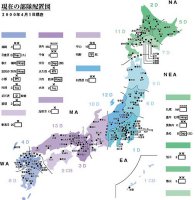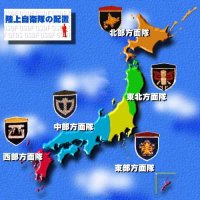Order of Battle - Japan Ground Self Defence Force

 | |
|
| |
| Hokkaido | |
|---|---|
|
Northern Army
|
|
| Honshu | |
|
Northeastern Army
|
|
|
Eastern Army
|
|
| Honshu & Shikoku | |
|
Middle Army
|
|
| Kyushu | |
|
Western Army
|
|
The GSDF was divided into five regional armies [the JGSDF uses a term that literally translates as "direction party"], each containing two to four divisions, antiaircraft artillery units, and support units. The largest, the Northern Army, was headquartered on Hokkaido, where population and geographic constraints were less limiting than elsewhere. It has four divisions and artillery, antiaircraft artillery, and engineering brigades. The Northeastern Army and the Eastern Army, headquartered in Sendai and Ichikawa, respectively, each has two divisions. The Middle Army [Central Army], headquartered in Itami, has three divisions in addition to a combined brigade located on Shikoku. The Western Army, with two divisions, was headquartered at Kengun and maintains a combined brigade [Mixed Group] on Okinawa.
There were two types of divisions [the JGSDF uses a term that literally translates as "teacher group"] in accordance with the personnel strength. They were a 9,000-man Division and a 7,000-man Division which were composed of a division headquarters, three to four infantry regiments, an artillery regiment, a tank battalion and other units. The organization of a division was standardized because of its role of conducting systematic defense operations in any part of Japan.
A brigade was a unit combined with various types of forces, including combat units, such as infantry, armored and artillery units, combat support units and logistical support units. It was a regionally independent and permanent entity. Though its function was similar to a division in that it possesses the capability to engage in operations on one front, it was smaller than a division in scale and has limited capability. (A division in principle consists of 6,000 to 9,000 personnel, whereas a brigade in principle consists of 3,000 to 4,000 personnel.)
Japanese Ground Self-Defense Forces planned in 2025 to establish two new major units in fiscal year 2026. First, the 15th Brigade, headquartered in Naha on Okinawa and responsible for the defense of the country's southwestern territory, was to be expanded into a division. Second, the Army's special forces were to be consolidated into a separate brigade.
The 15th was one of eight active independent brigades of the Ground Self-Defense Forces and was subordinate to the Army Western Command. It was established in 2010 as the successor to the 1st Combined Joint Forces Brigade. With approximately 2,300 personnel, it was relatively small and consists primarily of the 51st Infantry Regiment, which, like all such Japanese units, was actually a battalion.
In addition, there were two reinforced companies, each with approximately 350 troops, serving as security forces on the Miyako and Yaryama Islands, bordering the East China Sea and the Philippine Sea. The brigade also commands an anti-aircraft regiment with one light and three medium anti-aircraft batteries, a logistics battalion, a reconnaissance company with Type 87 armored personnel carriers, a helicopter company with CH-47s and UH-60s, and a communications, engineering, explosive ordnance disposal, and NBC defense company.
The expansion to a division will include a second infantry regiment, and the existing reconnaissance company will be disbanded and replaced by a new unit equipped with the Type 16 wheeled armored vehicle and other systems. Communications and logistics capabilities will also be strengthened. Nevertheless, the future division, one of ten in the Self-Defense Forces, will only have the strength of a full-fledged brigade at 3,900 personnel.
It was speculated that the "promotion" to the division was primarily intended to raise the commander's rank from major general to lieutenant general, in accordance with Japanese custom. Since the commander of the American III Marine Expeditionary Force of the US Marine Corps stationed on Okinawa holds the same rank, it was likely hoped that this will strengthen cooperation on an equal footing.
The organization of the future special forces brigade was not yet known. However, it will be subordinate to the Special Forces Group stationed in Funabashi, Chiba Prefecture, and the Central Readiness Regiment from Utsunomiya, Tochigi Prefecture. The former was a unit organized similarly to the American Delta Force, the British SAS, or the German KSK, with three operational companies and an estimated total strength of 300 personnel.
The Central Standby Regiment was essentially an infantry battalion equipped with protected and armored vehicles, with a strength of approximately 700 troops, designed to support special operations. Currently, it, along with the Special Forces Group, the 1st Airborne Brigade, and the 1st Helicopter Brigade, was subordinate to the Central Standby Force, established in 2007 and comprising approximately 4,500 troops.
The reasons for the reorganization were unclear, except that a new position for a major general was being created. With an active strength of approximately 150,000 troops and 56,000 reservists, the Japanese Ground Self-Defense Forces were already quite top-heavy: They have five army commands, currently nine divisions with 6,000 to 9,000 troops each, eight independent combat brigades, and ten support brigades, including five engineer brigades, two each artillery and air defense, and the aforementioned 1st Helicopter Brigade.
|
NEWSLETTER
|
| Join the GlobalSecurity.org mailing list |
|
|
|

